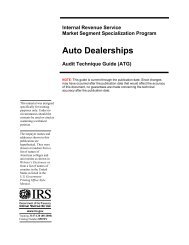Publication 963 (Rev. October 1997) - Uncle Fed's Tax*Board
Publication 963 (Rev. October 1997) - Uncle Fed's Tax*Board
Publication 963 (Rev. October 1997) - Uncle Fed's Tax*Board
Create successful ePaper yourself
Turn your PDF publications into a flip-book with our unique Google optimized e-Paper software.
Determining Worker Status<br />
NOTES<br />
Employee Benefits<br />
Providing the worker with employee benefits traditionally associated with employee<br />
status has been an important fact in several recent court decisions. See Weber v.<br />
Commissioner, 103 T.C. 378 (1994), aff’d 30 F. 3d (4th Cir. 1995); Lewis v. Commissioner,<br />
T.C. Memo 1993-635.<br />
If a worker receives employee benefits, such as paid vacation days, paid sick days, health<br />
insurance, life or disability insurance, or a pension, this constitutes some evidence of<br />
employee status. The evidence is strongest if the worker is provided with employee<br />
benefits under a tax-qualified retirement plan, IRC section 403(b) annuity, or cafeteria<br />
plan, because by statute these employee benefits can only be provided to employees.<br />
Some decisions, however, have ascribed less weight to the fact that employee benefits<br />
were provided (Butts v. Commissioner, T.C. Memo 1993-478, aff’d per curiam, 49F. 3d<br />
713 (11th Cir. 1995)).<br />
Other Governmental Characterizations<br />
State laws, or determinations of state or federal agencies, may characterize a worker as<br />
an employee for purposes of various benefits. For the purpose of determining worker<br />
classification with respect to federal employment tax liability and withholding requirements,<br />
characterizations based on these laws or determinations should be weighed with<br />
caution and in some cases disregarded, because the laws or regulations involved may use<br />
different definitions of employee or be interpreted to achieve particular policy objectives.<br />
Discharge or Termination<br />
The circumstances under which a business or a worker can terminate their relationship<br />
have traditionally been considered useful evidence bearing on the status the parties<br />
intended the worker to have. Some recent court decisions continue to explore such<br />
evidence. However, in order to determine whether the facts are relevant to the worker’s<br />
status, the impact of modern business practices and legal standards governing worker<br />
termination need to be considered.<br />
Under a traditional analysis, a government entity’s ability to terminate the work relationship<br />
at will, without penalty, provided a highly effective method to control the details of<br />
how work was performed and, therefore, tended to indicate employee status. Conversely,<br />
in the traditional independent contractor relationship, the government entity could terminate<br />
the relationship only if the worker failed to provide the intended product or service,<br />
thus indicating the parties’ intent that the business not have the right to control how the<br />
work was performed.<br />
In practice, however, the government entity rarely has complete flexibility in discharging<br />
an employee. The reasons for which a government entity can terminate an employee may<br />
be limited; by law, by contract, or by its own practices. As a result, inability to freely<br />
discharge a worker, by itself, no longer constitutes persuasive evidence that the worker is<br />
an independent contractor.<br />
Termination of Contracts<br />
A worker’s ability to terminate work at will was traditionally considered to illustrate that<br />
the worker merely provided labor and tended to indicate an employer-employee relationship.<br />
In contrast, if the worker terminated work and payment could be refused or the<br />
worker could be sued for nonperformance, this tended to indicate an independent<br />
contractor relationship.<br />
3-16 Federal-State Reference Guide (<strong>1997</strong> Edition)
















